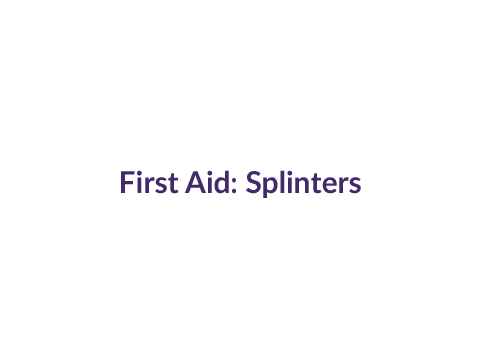Splinter, First Aid
A splinter, or sliver, is a particle of a foreign object, such as a small piece of wood or glass, that has embedded itself in the skin. Splinters can sometimes be pulled out easily, but others can be deeply embedded and difficult to remove. All splinters should be removed as promptly as possible. Keeping a splinter in the skin makes the area prone to infection.
Note: For splinters in the eye, see the topic Foreign Object in Eye or Skin.
Who's At Risk?
Splinters are very common and can affect anyone. People who are exposed to unfinished wood or machines that produce slivers of wood or metal are most prone to splinters.
Signs & Symptoms
Splinters often appear as a foreign object either fully or partially embedded in a person’s skin. Splinters can be small, large, smooth, jagged, deeply embedded, or only partially embedded. If the sliver is large or jagged, there may be bleeding and redness of the affected area. There may be no bleeding if the sliver is small or smooth.
Slivers often occur on the hands and feet, but they can occur anywhere on the skin or eyes that comes in contact with the foreign object.
Self-Care Guidelines
First Aid Guide
Self-care measures to remove a splinter:
- Wash your hands and clean the area with soap and water.
- Clean tweezers and a needle by pouring antiseptic solution (eg, isopropyl alcohol) over them and letting them dry.
- With the tweezers, attempt to pull out the splinter at the same angle it went into the skin. Using a magnifying class can help you see very small splinters.
- If the splinter cannot be removed by the tweezers because the tip is not accessible, use the cleaned needle to make a small hole above the splinter and use the needle to lift the splinter out.
- Once the splinter is fully out, wash the area, apply antibiotic ointment, and bandage it with a clean, dry dressing.
If the splinter is embedded in the skin under the nail, you can cut a V-shaped notch in the nail to allow access to the area.
Treatments
The medical professional will ensure that the splinter site is clean and free of debris.
If your last tetanus immunization was more than 5 years ago, your medical professional may want to give you a tetanus booster.
If the splinter site has become infected, the medical professional may treat the infection with antibiotics.
Visit Urgency
Seek medical care if:
- You have a splinter or other foreign body in your eye.
- You are unable to remove the splinter, or only part of a splinter was successfully removed by self-care measures and there is still a piece of foreign object in the skin.
- The skin around the splinter is particularly red, painful, swollen, or bloody.
- The site of a splinter appears to be infected (eg, it is increasingly painful, red, or swollen; there is discharge; there is associated fever or swollen lymph nodes; or there is red streaking from the affected area toward the heart).
- Your tetanus immunization is not up to date.
Trusted Links
Last modified on August 13th, 2024 at 7:26 am

Not sure what to look for?
Try our new Rash and Skin Condition Finder
